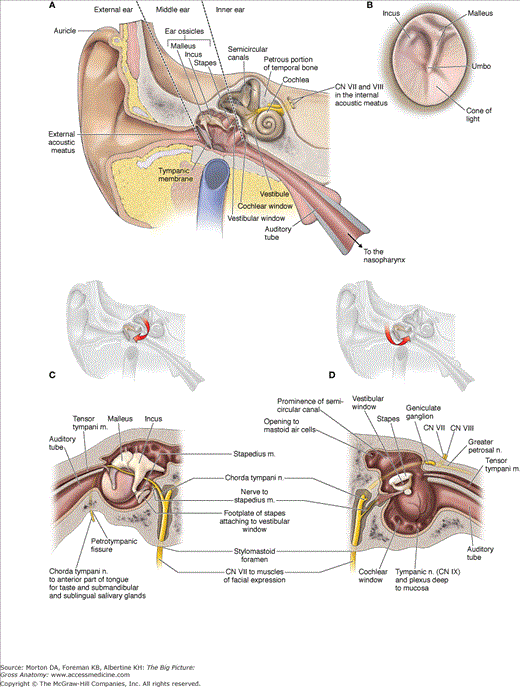The Ear
The external ear collects sound waves and transports them through the external acoustic meatus to the tympanic membrane. The tympanic membrane vibrates, setting three tiny ear ossicles (malleus, incus, and stapes) in the middle ear into motion. The stapes attaches to the lateral wall of the inner ear, where the vibration is transduced into fluid movement. The fluid causes the basilar membrane in the cochlea to vibrate. The vestibulocochlear nerve [cranial nerve (CN) VIII] receives and conducts the impulses to the brain, where there is integration of sound and equilibrium.
The external ear consists of the auricle, or pinna, which lies at the outer end of a short tube called the external acoustic meatus (Figure 19-1A). The auricle funnels sound waves through the external acoustic meatus to the tympanic membrane. The external ear receives general sensory innervation from the trigeminal, facial, and vagus nerves (cranial nerves (CNN) V, VII, and X, respectively) and from the great auricular nerve (cervical plexus C2–C3).
The tympanic membrane, or “eardrum,” is a three-layered circular structure (Figure 19-1A–C).
- Outer layer. Composed of modified skin that is continuous with the external acoustic meatus.
- Middle layer. Composed of connective tissue through which the chorda tympani nerve (CN VII) passes.
- Inner layer. Lined with the mucosa of the middle ear, and receives general sensory innervation via the tympanic plexus (CN IX).
 A physician uses an otoscope to view the health of a patient’s external and middle ear. One of the structures seen on the tympanic membrane is the where the handle of the malleus attaches on its internal surface. When a physician shines the light of the otoscope onto a healthy tympanic membrane, the malleus causes a cone of light to appear in the anterior–inferior quadrant (Figure 19-1B).
A physician uses an otoscope to view the health of a patient’s external and middle ear. One of the structures seen on the tympanic membrane is the where the handle of the malleus attaches on its internal surface. When a physician shines the light of the otoscope onto a healthy tympanic membrane, the malleus causes a cone of light to appear in the anterior–inferior quadrant (Figure 19-1B).
The middle ear is an air-filled chamber that transmits sound waves from air to the auditory ossicles and then to the fluid-filled inner ear (Figure 19-1A). The middle ear consists of the tympanic cavity proper, auditory tube, ear ossicles, and branches of CNN VII and IX.
The tympanic cavity proper is the space between the tympanic membrane and the vestibular window. Its mucosa receives general sensory innervation from the tympanic nerve and the tympanic plexus (CN IX) (Figure 19-1A–D). In addition, visceral motor preganglionic parasympathetic fibers from CN IX branch from the tympanic plexus to exit the middle ear as the lesser petrosal nerve on route to innervate the parotid gland.
- Vestibular (oval) window. A membrane-covered opening between the middle ear and the vestibule of the inner ear. The oval window is pushed back and forth by the footplate of the stapes and transmits the vibrations of the ossicles to the perilymph at the origin of the scala vestibuli in the inner ear.
- Cochlear (round) window. A membrane-covered opening that accommodates the pressure waves transmitted to the perilymph at the end of the scala tympani.
The auditory (eustachian) tube is an osseous–cartilaginous tube that connects the nasopharynx and the middle ear (Figure 19-1A
Stay updated, free articles. Join our Telegram channel

Full access? Get Clinical Tree



